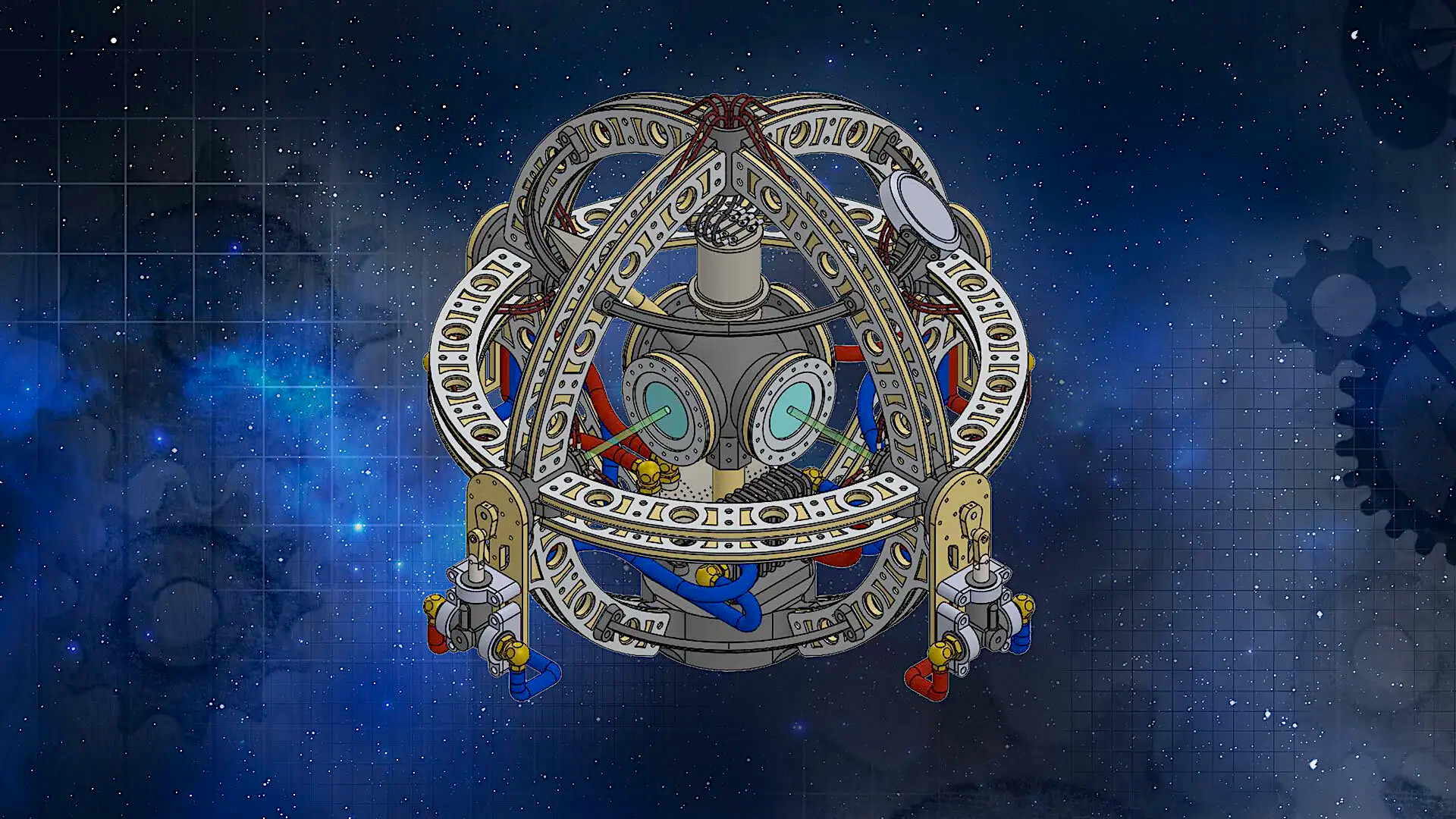
A technical drawing of a quantum steampunk engine, designed for a sculpture that Nicole Yunger Halpern's team is creating as part of an Arts for All grant. Yunger Halpern is co-teaching a class this semester that combines her scientific focus, quantum thermodynamics, with science fiction writing.
Illustration by Empire Group; background image by Adobe Stock
To help an interdisciplinary group of students channel their internal H.G. Wells, Edward Daschle gave his class a two-part task earlier this week: First, jot down a modern-day appliance and pass the paper to the left. Next, describe a “steampunk” version of the contraption you received.
Steampunk is an artistic genre that incorporates fantastic technologies into Victorian-era settings. Think steam engine-powered submarines surfacing in Sherlock Holmes’s London, or time machines invading the Wild West. The challenge, said the lecturer with the University of Maryland’s English department, was to conceive of machines that were scientifically plausible, albeit weirdly anachronistic.
One creation: a set of headphones powered by steam boilers in a 19th century basement, creating vibrations that send energy into the headphones’ diaphragms.
“People could also play the music on loudspeakers and accompany it with an instrument like a violin,” computer science major Greg Arnold ’25 explained to the class. “I wanted to create a notion of wealthy Victorian people.”
He and other students representing academic backgrounds spanning humanities and sciences have converged in this new course, “Writing Quantum Steampunk: Science-Fiction Workshop.” It offers English majors a peek into the complex world of quantum energy and STEM majors the unique chance to read fantasy fiction from authors like the widely lauded Terp N.K. Jemisin M.Ed. ’97 and write their own short stories with steampunk concepts.

“I hope we can get people to think more creatively about science within science fiction, strengthen the bridge between the sciences and humanities and maybe provide new inspiration for writers,” said Nicole Yunger Halpern, a theoretical physicist at the National Institute of Standards and Technology (NIST) and fellow of the Joint Center for Quantum Information and Computer Science, who is co-teaching the class with Daschle.
As a teenager, Yunger Halpern devoured books and films she later learned contained steampunk themes, like “The Golden Compass.” Despite her literary bent, she studied physics in college, and as a doctoral student at the California Institute of Technology, focused on developing a quantum version of thermodynamics—the study of heat, cooling and energy efficiency, with roots in the development of the steam engine during the Industrial Revolution.
Yunger Halpern identified the parallels between the new field of quantum thermodynamics and the steampunk genre. Just as the former combines cutting-edge concepts with 19th century science, the latter does the same with art. In that sense, quantum thermodynamics “strikes me as the real-world incarnation of steampunk,” she said.
She coined the term “quantum steampunk,” which in 2022 became the name of her award-winning book, subtitled “The Physics of Yesterday’s Tomorrow.” The following year, Science News named her one of 10 “Scientists to Watch,” and last year she was part of a team that received a UMD Arts for All grant to design a sculpture of a quantum steampunk engine.
Daschle, whose writing has appeared in After Dinner Conversation magazine and the Apex Book Company anthology "Robotic Ambitions,” and who created a science fiction and fantasy workshop at UMD through the Jiménez-Porter Writers’ House, was already familiar with Yunger Halpern’s steampunk work. In 2022 and 2023, she had run a quantum steampunk short story contest (requirements: Submitted stories must take place in the Victorian era, and must feature at least one quantum technology), and one of the contest judges was UMD Associate Professor of English Emily Brandchaft Mitchell, Daschle’s MFA adviser. When Yunger Halpern expressed her desire to collaborate with creative writers, Mitchell put her in touch with Daschle. He found her concept ambitious. “I enjoy the idea of meshing things that don’t seem to work together to create new ideas,” he said.

Daschle (pictured left) suggested they co-teach a class, where science would assume a role of literary character. Yunger Halpern agreed.
“The course allows English students to become science insiders,” he said. “For science students, we thought, “How can we introduce their scientific research into science fiction?’ ”
Gaya Premawardhana, a fourth-year doctoral student in physics, was thrilled to learn about the class. Her career ambitions were influenced by films like the original “Star Wars” film and the book version of “2001: A Space Odyssey.” She now counts science fiction writing among her hobbies.
Still, she said, “I’ve never taken a creative writing class, and this was a good opportunity to increase my skills.”
Back in the classroom, as students continued creating steampunk concepts based on modern appliances, Daschle challenged them to consider their utility, questioning how they might change Victorian society.
“Make your ideas more elastic, and we’ll come up with up with some wildly different inventions,” he said.
—Story by John Tucker, Maryland Today staff